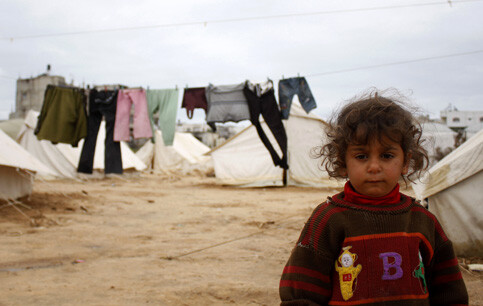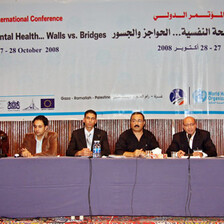The Electronic Intifada 11 May 2009

Few in the Gaza Strip were left unscarred by Israel’s recent onslaught. (Hatem Omar/MaanImages)
GAZA CITY, occupied Gaza Strip (IPS) - Palestinians in Gaza have a colloquial term to describe the buzzing of Israeli warplanes that is an ever-present feature of their lives: zanana.
The gallows humor of likening instruments of death to honey bees might suggest that the people of this crowded sliver of land on the Mediterranean have found a way of coping with the occupation that has lasted more than four decades. Yet the planes also remind Palestinians of what they fear most: that they could come under fresh attack at any time.
The destruction to property caused by the 23-day bombardment which the Gaza Strip endured in December and January remains visible in many parts of its main city.
In the Izbet Abed Rabo area last week, a herd of goats was steered through a street where all that remains of many houses is slabs of concrete and girders piled on top of each other. Tents provided by different United Nations agencies are the only shelter that the residents of these flattened buildings now have.
Despite pledges running into billions of dollars made at a donors conference in the Egyptian resort of Sharm al-Sheikh in March, work on transforming this apocalyptic vision into a place where those uprooted can live with a semblance of dignity has not yet begun, because Israel is restricting the importation of sorely-needed building material.
Amidst all this, the psychological effects of the attack are less apparent, but the preliminary findings of an ongoing survey being conducted by the Gaza Community Mental Health Programme (GCMHP) suggest that few people, if any, are left unscarred.
In a sample of 374 children studied, more than 73 percent thought they were going to die during the violence. Almost 68 percent of them — all aged between six and 16 — fear that a similar attack will come again, and 41 percent expressed a strong desire for revenge.
Of the parents examined by mental health professionals as part of the same study, 59 percent of fathers and 75 percent of mothers were diagnosed with post-traumatic stress disorder. Among the symptoms detected were that over 59 percent of these adults were anxious about death, that half of them feared heart attacks, and about 15 percent feared contracting cancer because of exposure to weapons such as white phosphorous.
Meanwhile, 82 percent of parents observed that their children have been behaving aggressively since the attack, and 52 percent reported that their children had emotional problems.
“Everybody lost something in this war,” GCMHP spokesman Husam al-Nounou told IPS. “Some lost friends and relations, some lost parts of their bodies. Others lost property and money; others a feeling of security and protection. It was a very cruel feeling. I’ve never felt so near to death as during that period. There was no place to where we could escape.”
A cartoon pinned to the wall of the Israeli government press office in Jerusalem seeks to illustrate the official and oft-repeated view that Israel boasts the most moral army in the world.
Opposite sides of a frontier have an Israeli general upbraiding one of his recalcitrant officers, and a senior figure in an Islamic militant organization giving a similar ticking off to a rank-and-file member. The Israeli general says, “There was a whole family there, how could you shoot?” The Islamic militant says, “There was a whole family there, how could you miss?”
But that is an Israeli cartoon. There is a widespread feeling in Gaza that Israel did not take genuine precautions to ensure that civilian casualties were minimized. Majed Abu Salama, a technology student, says that a friend of his family was killed when he went outdoors on an afternoon when Israel had promised a temporary halt to its offensive.
“They killed him through a rocket, when his daughters and his wife were with us in my family’s house,” Abu Salama said. “It was terrible.”
Making ends meet was already a formidable task for the vast majority of Gazans before the attack. In 2006 — shortly after a surprise victory by Hamas in legislative elections — senior advisor to the Israeli government Dov Weissglas said that he wished to give Gazans “an appointment with a dietician” so that they “will get a lot thinner but won’t die.”
As part of an economic blockade, the number of basic commodities allowed into the strip was severely restricted, and Gazans employed in Israel were no longer allowed to go to work. Poverty and unemployment levels soared as a result. All this has taken a toll on minds.
Khalil Abu Shammala, director of the Al-Dameer Association for Human Rights, says that most Gazans require counseling.
“We can see this easily if we just walk along the street and look at people’s eyes,” he said. “We have to understand that Gazans have been under a very severe siege for the past three years. Nobody can travel, and even the basic needs of the population cannot be provided for. So many families don’t have enough money to provide milk for their children.
“I know so many fathers who leave their houses early in the morning and come back late at night because they don’t want to stand before children asking them for just one shekel [0.24 dollars] that they do not have.”
Near what remains of the Palestinian Legislative Council headquarters — bombed in the early stage of the Israeli offensive — Nahed Wasfy Wshah stops foreigners, asking them if he might be able to obtain asylum in their country.
“My children, my daughters are still scared by the war,” he says to one. “Sometimes they wake up at night and start screaming. They say: ‘Daddy, take us away from here; there will always be war here.’”
All rights reserved, IPS - Inter Press Service (2009). Total or partial publication, retransmission or sale forbidden.





